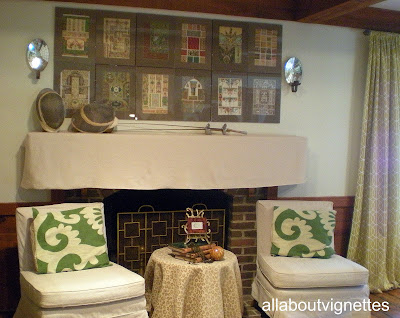I haven't done much on the blog about painting furniture, but let me share that when I had the store I was a furniture painting machine. One of the problems I frequently encountered when refurbishing vintage were pieces with damaged veneer. Sometimes, I just didn't buy them. Other times I purchased them and spent hours removing the entire section and then sanding. Other times I filled and sanded or when I was feeling particularly ambitious, actually repairing the damage with another piece of veneer.
That was until I discovered Anaglypta textured wall covering. It is applied just like wallpaper, but it is textured with a raised design. It's also fairly thick and can cover flaws on walls or furniture. It comes in many patterns, some even imitating the design of a tin ceiling tile. I purchased a roll of it at Lowe's. Mine has a floral pattern.
To see more patterns and designs, go here.
 |
| Anaglypta Wall Covering |
To see more patterns and designs, go here.
Originally I had painted this sweet side table a Swedish gray.
I thought I had sanded the top smoothly enough, but not so. I don't know if the wet paint made the veneer buckle, or if I didn't do enough prep, but the top looked like this.
Anaglypta to the rescue. Here are the steps I used to cover the damage.
First, I placed the wall covering on top of the table. I smoothed it out and then folded it over the whole way around the table top to make a pattern. I creased it with my thumb, but you could also use a wooden popscicle stick or old credit card to get a sharp edge.
Obviously it's easier to apply this product on a straight-sided surface like a door or the side of a dresser, which I've done many times.
Next, I cut out the pattern and put it onto the table top to make sure it was a good fit. I usually have to trim again in a few places.
After that, you're ready to apply the covering. It's pre-pasted so you wet it and then have to "book it" to activate the paste. "Book it" means that you lightly fold it over with the inside touching. You leave it like this for a few minutes.
Now you're ready to apply it. Start on one side and smooth it out until you've covered the entire surface. Work from left to right or top to bottom. Make sure you have no air bubbles or bumps. Lift it up and re-apply before it dries if you see any. Or, if you notice a bump afterwards, use a safety pin or needle to prick a small hole, press to release the air bubble.
I find that an old credit card works to press it down. It's also a good idea to use the credit card around the edge too.
Don't be upset if you think that you did a great job and an edge comes up while it's drying. Just squirt a dab of glue there and press it down.
I waited until it was dry, then applied two coats of paint.
Here's the finished product.
Sometimes solutions to problems create something unique,
and sometimes even better than the original idea.
What do you think?
ENJOYED THIS POST?
Sign up to receive a notification every time I publish by clicking here.
I thought I had sanded the top smoothly enough, but not so. I don't know if the wet paint made the veneer buckle, or if I didn't do enough prep, but the top looked like this.
Anaglypta to the rescue. Here are the steps I used to cover the damage.
First, I placed the wall covering on top of the table. I smoothed it out and then folded it over the whole way around the table top to make a pattern. I creased it with my thumb, but you could also use a wooden popscicle stick or old credit card to get a sharp edge.
Obviously it's easier to apply this product on a straight-sided surface like a door or the side of a dresser, which I've done many times.
Next, I cut out the pattern and put it onto the table top to make sure it was a good fit. I usually have to trim again in a few places.
After that, you're ready to apply the covering. It's pre-pasted so you wet it and then have to "book it" to activate the paste. "Book it" means that you lightly fold it over with the inside touching. You leave it like this for a few minutes.
Now you're ready to apply it. Start on one side and smooth it out until you've covered the entire surface. Work from left to right or top to bottom. Make sure you have no air bubbles or bumps. Lift it up and re-apply before it dries if you see any. Or, if you notice a bump afterwards, use a safety pin or needle to prick a small hole, press to release the air bubble.
I find that an old credit card works to press it down. It's also a good idea to use the credit card around the edge too.
Don't be upset if you think that you did a great job and an edge comes up while it's drying. Just squirt a dab of glue there and press it down.
I waited until it was dry, then applied two coats of paint.
Here's the finished product.
Sometimes solutions to problems create something unique,
and sometimes even better than the original idea.
What do you think?
ENJOYED THIS POST?
Sign up to receive a notification every time I publish by clicking here.



















































